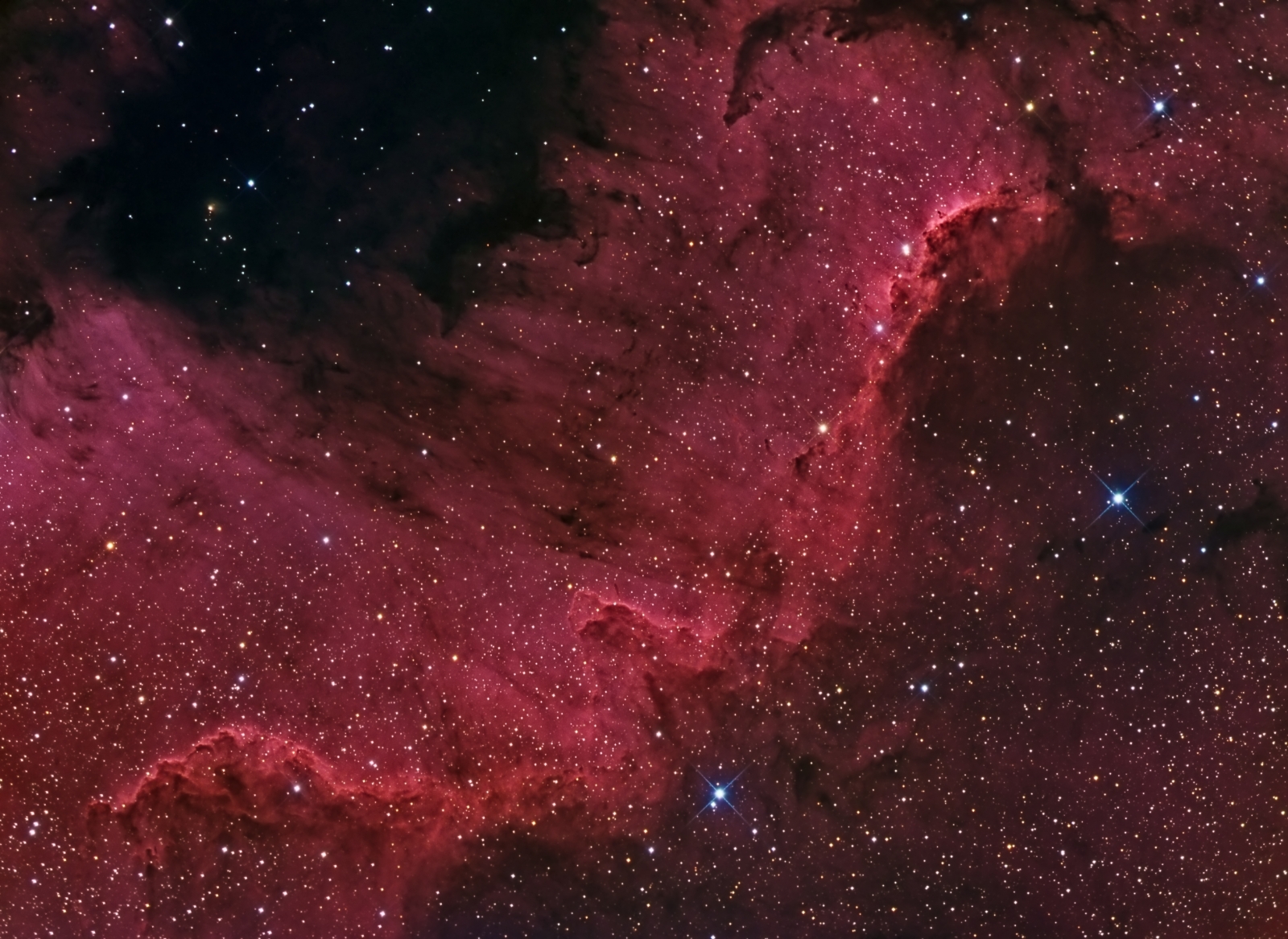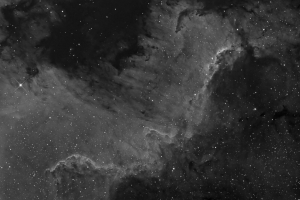Southern NGC7000 – The Cygnus Wall
 Click image for full size version
Click image for full size version
August 8, 2015
NGC7000 is known as the North America nebula, because it’s shape is similar to that continent. Although it is much too large to capture in a single frame with my imaging 1700 mm focal length setup, several regions within it make interesting subjects in their own right. This image shows the southern part of the nebula, corresponding to “Central America,” with the “Gulf of Mexico” towards top left. This may be easier to visualize in a rotated image. Sometimes referred to as the Cygnus Wall, this nebula lies around 1600 light years away, and is glowing due to emissions from atoms of hydrogen gas.
 This image blends the red, green and blue colour channels with data collected through a deep red H-alpha filter. The black and white image at right shows just the H-alpha data alone. A full size image is available by clicking on the image.
This image blends the red, green and blue colour channels with data collected through a deep red H-alpha filter. The black and white image at right shows just the H-alpha data alone. A full size image is available by clicking on the image.
Tekkies:
SBIG STL-11000M camera, Baader Ha, R, G and B filters, 10″ f/6.8 ASA astrograph, Paramount MX. Guided with STL-11000’s external guider and 80 mm f/6 Stellar-Vue refractor. Acquisition and guiding with TheSkyX. Focusing with FocusMax. Automation with CCDCommander. Calibration, cosmetic correction, registration, integration and all processing in PixInsight. Shot from my SkyShed in Guelph, Ontario. Nearly full Moon for Ha and last quarter moon for RGB. Good to very good transparency and average to very good seeing throughout acquisition.
13x15m R, 11x15mG, 11x15mB and 9x30m Ha unbinned frames (total=13hr15m).
HaRGB
Creation and cleanup: Ha, R, G and B masters were cropped and processed separately with DBE. R, G and B were combined to make an RGB image which was processed with ColourCalibration. The NB-RGBCombine Script was applied with default settings to produce a linear HaRGB image.
Linear Noise Reduction: MultiscaleLinearTransform was used to reduce noise in the background areas. Layer settings for threshold and strength: Layer 1: 3.0, 0.5 Layer 2: 2.0, 0.35 Layer 3: 1.0, 0.2 Layer 4: 0.5, 0.1
Stretching: HistogramTransformation was applied to make a pleasing yet bright image. TGV Noise was applied and the image was re-stretched to reset the black point.
Synthetic Luminance:
Creation and cleanup: The cleaned up Ha, R,G and B masters were combined using the ImageIntegration tool (average, additive with scaling, noise evaluation, iterative K-sigma / biweight midvariance, no pixel rejection).
Deconvolution: A copy of the image was stretched to use as a deconvolution mask. A star mask was made from unstretched SynthL to use as a local deringing support. Deconvolution was applied (100 iterations, regularized Richardson-Lucy, external PSF made using DynamicPSF tool with about 20 stars; local deringing at 70% and global dark deringing at 0.02).
Linear Noise Reduction: MultiscaleLinearTransform was applied to reduce the noise. Layer settings for threshold and strength: Layer 1: 3.0, 0.5 Layer 2: 2.0, 0.35 Layer 3: 1.0, 0.2 Layer 4: 0.5, 0.1
Stretching: HistogramTransformation was applied to make a pleasing yet bright image. TGV Noise was applied and the image was re-stretched to reset the black point.
HDR Multiscale Transformation: HDRMT was applied at 6 and 4 pixel scales using a mask to protect stars. LHE was applied at scales of 50 and 150 using the same star mask (strength 0.25 for both).
Combining SynthL with HaRGB:
The luminance channel of the HaRGB image was extracted, processed and then added back into the HaRGB image as follows:
1. Extract luminance from the HaRGB image.
2. Apply LinearFit using SynthL as the reference.
3. Use ChannelCombination in Lab mode to replace the HaRGB’s luminance with the fitted luminance from step 2.
4. LRGBCombine was then used to make a SynthLHaRGB image.
Final Processing
Star shapes were smoothed and sizes reduced by applying MorphologicalTransformation through the same star mask using the Midpoint operator, with default settings. A light unsharp mask was then applied to the stars. A range mask for the brightest highlights minus stars was made by subtracting a star mask from a range mask. The highlights were sharpened slightly with unsharp mask. Overall contrast and brightness were increased slightly with the Curves tool.
Image scale is about 1.1 arcsec per pixel for this camera / telescope combination.






Leave A Comment